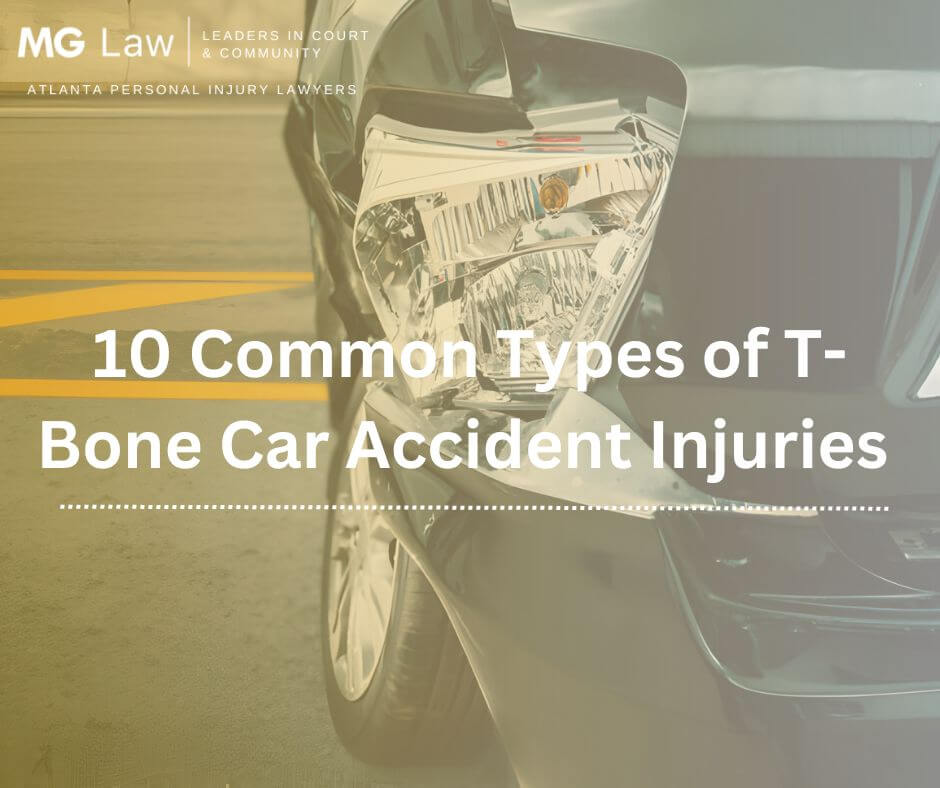
T-bone accidents get their name from the distinct impact point forming a “T-shape” where one vehicle’s front collides with the side of another. These accidents can result in significant damage, especially if one vehicle is larger than the other. Victims are less protected than other rear or front-end collisions, which can lead to devastating T-bone car accident injuries.
A T-bone crash can subject vehicle occupants to multiple forces, from the side impact followed by subsequent contact within the vehicle’s interior. That can lead to a wide array of injuries, from soft tissue to catastrophic brain injuries.
Given the proximity of vehicle occupants to the point of impact, T-bone accident injuries are usually severe and can also lead to long-term physical and psychological trauma. Familiarizing yourself with common injuries from a T-bone car accident is essential if you plan to bring a personal injury claim. Read on to learn more about the 10 most common T-bone car accident injuries.
Get in touch with MG Law by dialing (770) 988-5252 to set up a complimentary consultation without any commitments.
1. Whiplash
Whiplash is one of the most common injuries in T-bone accidents. It happens when collision forces cause your neck and head to whip back and forth. That sudden movement can stretch or tear your muscles, resulting in stiffness, pain, and reduced mobility.
Whiplash symptoms include headaches, stiffness and pain, dizziness, and sometimes blurred vision or tinnitus. While a T-bone collision injury like whiplash can appear immediately, it’s common for symptoms to appear a day or more later. Treatment varies depending on your case. You might need physical therapy or wear a cervical collar.
2. Chest Injuries
Chest injuries range from mild bruising to severe trauma, including broken ribs and injuries to internal organs. There’s also a risk of complications such as a punctured lung. Watch for key symptoms such as chest pain or difficulty breathing. Victims might also notice bruising and visible chest wall deformities.
It’s imperative to seek medical treatment right away if you suspect a chest injury. Some chest injuries, especially any involving internal organs, might not be immediately apparent. You need a doctor to diagnose you, as it might require one or more tests to see what is happening.
Treatment options depend on the severity of your chest injury. Surgery might be necessary if your injury is potentially life-threatening.
3. Spinal Cord Injuries
Spinal cord injuries are among the most severe injuries in car accidents. In many cases, these injuries result in permanent paralysis. Symptoms of a spinal cord injury include no feeling or ability to move below a certain level that corresponds to where your spinal cord is damaged. For example, injuries to the neck might mean you cannot move your arms and legs.
Immediate medical attention is crucial for spinal cord injuries. Timely treatment can prevent further damage and improve your long-term prognosis. Potential treatment might involve surgery, immobilization, and rehabilitation. Victims who have permanent paralysis will need lifelong assistance.
4. Brain Injuries
Head injuries in car accidents can range from mild concussions to traumatic brain injuries (TBIs). If you experienced a violent jolt or your head hit something during the collision, you are at risk of a brain injury. If you’ve experienced a head injury in the past, such as a concussion, you are at a greater risk for a more severe injury now.
Mild symptoms such as headaches or temporary confusion are common with concussions, while severe injuries include a loss of consciousness, memory problems, behavioral changes, and more. Some brain injury symptoms might not develop immediately following an accident. Instead, they might develop over time, so watching for new signs is crucial.
5. Fractures and Broken Bones
Fractures and broken bones can range from simple fractures, which may heal with immobilization, to complex breaks requiring surgical intervention. Common locations for fractures and breaks include upper and lower extremities, ribs, and hips. Symptoms include severe pain, swelling, bruising, and visible deformities in the affected limb.
Prompt medical evaluation is necessary to diagnose whether you have a broken bone. X-rays or other diagnostic tests can show doctors how extensive the fracture is. Treatment will depend on the outcome of the diagnostic images. The doctor might need to set the bone or immobilize it with a cast or splint. In severe cases, doctors might want to insert pins, rods, or plates, which will require one or more surgeries.
Physical therapy is usually a vital component of the recovery process, helping to restore strength and mobility.
6. Abdominal Injuries
Abdominal injuries can be life-threatening because there are so many organs in this region, such as the spleen, liver, and kidneys. Watch for symptoms such as pain, swelling, and bruising in the abdomen. Treatment options will depend on the type and severity of your abdominal injury. Emergency surgery might be necessary in life-threatening cases.
7. Pelvic Injuries
T-bone accidents can result in severe pelvic injuries, including dislocation and related organ damage. Pelvic injury symptoms include pain, difficulty walking, and swelling. Prompt medical attention for pelvic injuries is crucial. Treatment may involve surgery, physical therapy, and extensive rehabilitation.
8. Lacerations and Bruises
Lacerations and bruises are common injuries in T-bone accidents. Shattered glass or sharp metal edges can cause lacerations. These injuries range from superficial cuts to deep wounds requiring immediate medical attention. Bruises can happen when you hit something in the vehicle, which damages blood vessels under the skin.
Symptoms include visible cuts, bleeding, pain, and discoloration of the affected area. Immediate treatment for lacerations may involve cleaning the cut and sutures. Bruises typically heal independently, but severe cases may need medical evaluation to rule out underlying damage. There’s always a risk of infection and scarring with lacerations, which is why proper wound care is crucial.
9. Internal Injuries
Internal injuries can be life-threatening. For example, there’s a risk of aortic dissection in a T-bone accident, which is where the large blood vessel from the heart tears. Blood enters through the tear, separating aorta layers, which can be deadly. Organ shear can happen from seat belt syndrome, which is a tear to one of your organs, such as the intestines.
Symptoms may not be immediately apparent, making internal injuries particularly dangerous. They can include internal bleeding, pain, dizziness, and fainting. Medical evaluation often involves imaging tests like CT scans or ultrasounds to diagnose the extent of the injury. Treatment will depend on the injury, but emergency surgery is often necessary.
Complications with internal injuries include infection and organ failure. That’s why early detection and diagnosis are crucial.
10. Psychological Injuries
Psychological injuries are a significant yet often under-acknowledged consequence of T-bone accidents. Anxiety, depression, and post-traumatic stress disorder (PTSD) are common psychological issues many victims face after an accident. You might experience persistent fear, flashbacks, mood swings, sleep disturbances, and a sense of detachment from everyday life. Symptoms can manifest immediately after the accident or develop gradually over time.
The impact of psychological injuries can be profound, affecting your ability to return to work, engage in social activities, and perform regular daily tasks. If you’re experiencing psychological symptoms after a T-bone accident, it’s crucial to seek treatment. Support from family, friends, and support groups is also an essential part of the recovery process.
Contact a Georgia Car Accident Lawyer
If you suffered injuries in a T-bone accident, it’s essential to consider hiring a Georgia car accident lawyer. You need a legal advocate who will protect your rights every step of the way. At MG Law, we have years of experience representing injured victims. We understand the complications and long-term impacts of T-bone car accident injuries.
Don’t try to handle your claim independently. Instead, contact MG Law at (770) 988-5252 to schedule a free, no-obligation consultation. Let us review your case and help you pursue justice for your damages.

